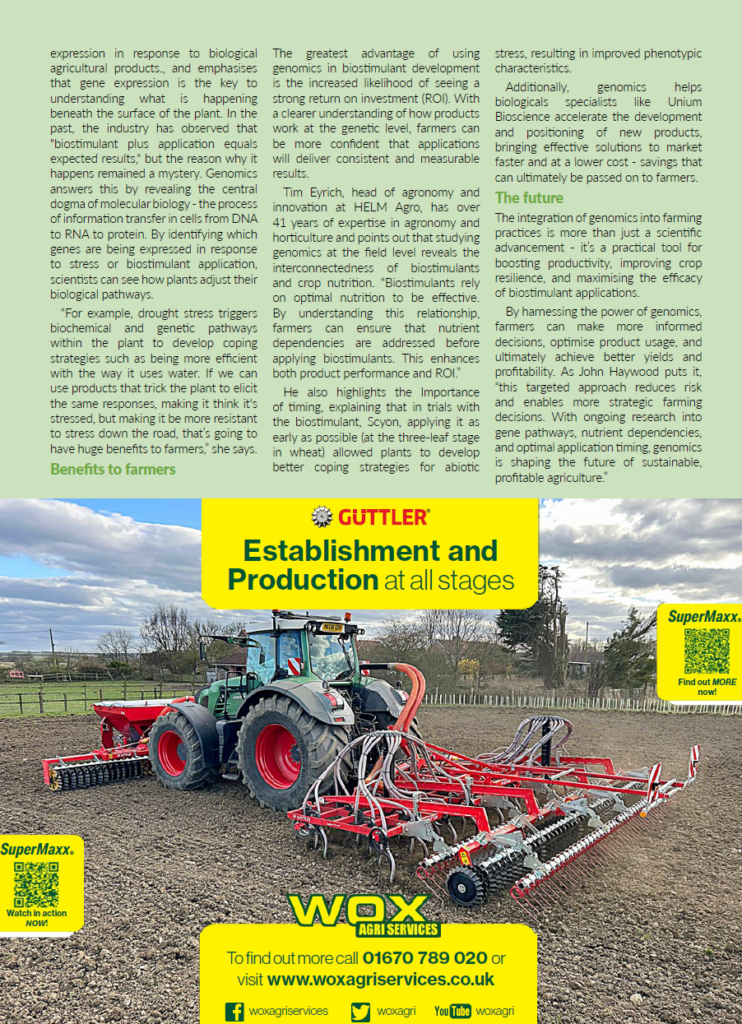Biostimulants are becoming a staple in agriculture, enabling growers to boost crop health, resilience, and yields in a cost-effective way. Until now, farmers and agronomists have assessed the efficacy of these products through phenotypic observations – measuring visible changes such as larger root systems, greener leaves, or improved overall plant vigour. While this approach has served the industry well, genomics is now enabling a deeper, more precise understanding of how and why these changes occur.
What is plant genomics?
Plant genomics is the field that explores the complete genetic blueprint of plants, including their DNA structure, function, evolution, and interactions, with the aim of gaining insights into plant biology and enhancing crop performance.
The benefits of biostimulants are generally evaluated based on physical changes observed in the field. For example, data from the University of Nottingham has shown how certain biostimulants lead to enhanced root growth and greener leaves. However, this only tells part of the story. With genomics, it’s possible to go beyond surface-level observations and identify the genotypic responses driving these visible improvements.
“Genomics is not about altering the plant’s DNA, it’s about understanding genetic pathways and behaviour, i.e. ‘reading the book without altering the words,’” explains John Haywood, at Unium Bioscience. “It’s our aim to understand the link between plant biology, genetics, nutrition, and biostimulants, to create solutions for growers, allowing us to build a deep understanding of the mode of action of our products,” he says.
John Haywood explains that this targeted approach enables the creation of more reliable and lower-cost solutions for farmers. He highlights that 60-70% of crop production is lost to abiotic stress (environmental stress) compared to just 20% lost to biotic stress (pests, diseases, and weeds). “However, only around 40% of farmers are using biostimulants and biologicals to mitigate biotic stress. With genomics, farmers have the power to use reliable science to create future solutions, addressing both biotic and abiotic stress more effectively.”
Understanding plant stress at a genetic level
Genomics provide valuable insights into how crops respond to abiotic and biotic stresses. Whether plants are facing drought, heat, cold, or disease pressure, genomic analysis reveals which genes are being upregulated or downregulated -essentially showing how the plant is reacting on a molecular level.
Layne Ellen Harris PhD, owner and research consultant at Foresight Agronomics, specialises in plant gene expression in response to biological agricultural products., and emphasises that gene expression is the key to understanding what is happening beneath the surface of the plant. In the past, the industry has observed that “biostimulant plus application equals expected results,” but the reason why it happens remained a mystery. Genomics answers this by revealing the central dogma of molecular biology – the process of information transfer in cells from DNA to RNA to protein. By identifying which genes are being expressed in response to stress or biostimulant application, scientists can see how plants adjust their biological pathways.
“For example, drought stress triggers biochemical and genetic pathways within the plant to develop coping strategies such as being more efficient with the way it uses water. If we can use products that trick the plant to elicit the same responses, making it think it’s stressed, but making it be more resistant to stress down the road, that’s going to have huge benefits to farmers,” she says.
Benefits to farmers
The greatest advantage of using genomics in biostimulant development is the increased likelihood of seeing a strong return on investment (ROI). With a clearer understanding of how products work at the genetic level, farmers can be more confident that applications will deliver consistent and measurable results.
Tim Eyrich, head of agronomy and innovation at HELM Agro, has over 41 years of expertise in agronomy and horticulture and points out that studying genomics at the field level reveals the interconnectedness of biostimulants and crop nutrition. “Biostimulants rely on optimal nutrition to be effective. By understanding this relationship, farmers can ensure that nutrient dependencies are addressed before applying biostimulants. This enhances both product performance and ROI.”
He also highlights the Importance of timing, explaining that in trials with the biostimulant, Scyon, applying it as early as possible (at the three-leaf stage in wheat) allowed plants to develop better coping strategies for abiotic stress, resulting in improved phenotypic characteristics.
Additionally, genomics helps biologicals specialists like Unium Bioscience accelerate the development and positioning of new products, bringing effective solutions to market faster and at a lower cost – savings that can ultimately be passed on to farmers.
The future
The integration of genomics into farming practices is more than just a scientific advancement – it’s a practical tool for boosting productivity, improving crop resilience, and maximising the efficacy of biostimulant applications.
By harnessing the power of genomics, farmers can make more informed decisions, optimise product usage, and ultimately achieve better yields and profitability. As John Haywood puts it, “this targeted approach reduces risk and enables more strategic farming decisions. With ongoing research into gene pathways, nutrient dependencies, and optimal application timing, genomics is shaping the future of sustainable, profitable agriculture.”


